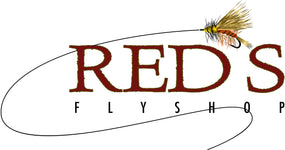CALL NOW (509) 933-2300
CALL NOW (509) 933-2300

Mend, mend, mend, mend. If you've been on a guided float, you've no doubt heard this again and again. We sound like a broken record. On any given day of fishing, you'll probably mend more than you cast. It's important. The cast gets it there, but often the mend is what gets the bite!
First off, not all mends are the same! There is an infinite variety of what mending can look like, but I like this definition:
MEND: Defined as "any manipulation of the fly line that promotes an improved presentation of the fly."
You'll need to mend while dry fly fishing, nymph fishing, and streamer fishing with both floating lines and sink tips. Sometimes mends are upstream, downstream, or neutral when the fly is under tension and just needs a little slack. It all depends on the goals. Before you watch the video, I'm going to lay out a basic outline here.
Mending Basics
Dry Fly Fishing
The common goal with dry flies is to float the fly downstream completely slack and "drag free" without any tension in the line. There are exceptions if you want to twitch or skate the fly, but most of the time, a natural "dead drift" is preferred. The most common mend here is an upstream mend to eliminate the centrifugal force the current puts on the line and inevitably on the dry fly. A dry fly that has tension makes a tiny wake, like a water skier might, and trout typically don't like that! They learn quickly that flies that make a V-wake bite back. Yuck! It doesn't take a trout long to learn that.
There are exceptions, of course. If you cast over slow water into fast water, you'll need to mend downstream for your line to keep up with the faster-paced fly. It's not always the same; it's important to just watch your fly and make instinctual adjustments to the line that will promote a dead drift.
Nymph Fishing
The mend needs to accomplish a couple of things. Let's assume you are using a strike indicator for the easiest explanation. The indicator is simply part of the line, and to get the best drift and help sink your flies, you'll need to mend the indicator the same way you mend the line. When fishing these rigs, don't treat your indicator as though it's your fly.... it's not. Your flies are beyond the indicator, so try and visualize what your mend is doing to the flies. You'll need to have several mends ready for nymphing: upstream mends that flop the indicator upstream, often called an "anchor" mend, a downstream mend when fishing over the top of slower water to faster water, and you'll need a "feeding mend" where you actually dish line out during your mends to keep those nymphs down deeper. We do this in dry fly fishing too, but because nymphs require some time to sink, prolonging a nymph drift is more critical. There is obviously more to it than this, but those are the basics.
Streamer Fishing
Mends control several elements of a streamer presentation. The mend can help your streamer sink, the speed at which it comes across the river, and the path the streamer will take. You can mend downstream to speed it up (my favorite!), and you can make multiple mends during a presentation or retrieve to direct your streamer toward structure. Think about a log, boulder, or other "fishy" structure and how you might mend the line to set a strategic path for the streamer. An upstream mend that promotes slack will help your streamer sink, or a "hump" mend will momentarily sink the fly. This mend is a straight up and down snap of the rod tip that is neither up nor down, but it slacks the streamer for a couple of seconds, allowing it to fall in the water column.
